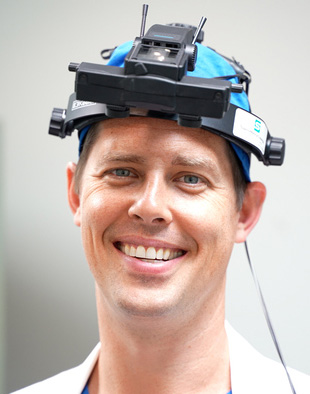
Living with Age-Related Macular Degeneration
Age-related Macular Degeneration (AMD) can be frightening. As the leading cause of vision loss, Macular Degeneration affects more than 10 million Americans – which is more than those affected by cataracts and glaucoma combined.
Many research studies are attempting to define preventative measures, or even a cure, for AMD, but currently, macular degeneration is classified as a chronic and incurable disease, meaning it can last for years or be lifelong. The good news? AMD can be treated, and when diagnosed as early as possible, the effects of this condition can be extremely minor.
Quality treatment starts with a firm understanding. Here’s some information about the disease that can help you realize what a future with AMD holds as well as help you explore treatment options.
What is AMD?
Age-related Macular Degeneration refers to the deterioration of the macula. The macula lives at the back of the eye and is the central part of the retina — the tissue that lines the inside of the eye. Light enters the eye and is focused onto the macula. The macula then sends images to the brain, where they are processed.
The macula is a sophisticated structure within the eye, and one of defining features of being a human. It’s responsible for clarity of images and vibrancy of colors. It also provides us with central vision and allows us to see in detail, both crucial functions for the purposes of reading and writing.
The disease is often classified into two main categories, wet AMD and dry AMD:
What Is Dry AMD?
Dry (atrophic) AMD is usually the less-severe classification of macular degeneration, developing as the eye ages. Approximately 85% to 90% of the cases of macular degeneration are considered dry AMD.
Dry AMD can make your vision wavy or fuzzy, making it difficult to read, see well in places with low light, or recognize faces. It’s usually slow to progress, but later symptoms of dry AMD can include dark spots that block your central vision completely.
Those with dry AMD can develop wet AMD, and along with it, experience more severe symptoms.
What Is Wet AMD?
Wet (neovascular) AMD is more severe. About one in 10 people with dry AMD will develop wet AMD. When an individual has wet AMD, blood vessels grow under the retina. These blood vessels can leak blood or fluid, causing swelling or permanent macular scarring.
Those with wet AMD can experience a loss in color and blurry or blind spots in their central vision. Wet AMD can lead to blindness.
Stargardt Disease and Diabetic Retinopathy
While macular degeneration usually occurs in older individuals, Stargardt disease, or juvenile macular degeneration, is an exception. It can occur during childhood or adolescence. This is an inherited disorder caused by the presence of gene ABCA4. The chances of a child or teenager of being diagnosed with Stargardt disease is one in 20,000. It’s estimated that 1 in 8,000-10,000 people have Stargart disease.
Those with Stargardt disease may experience a sensitivity to light, color blindness, hazy spots in the center of vision, and may begin to lose some peripheral vision as they age.
Diabetic retinopathy is also caused by changes in the retina’s blood vessels. This disease doesn’t always have noticeable symptoms and has to be caught and treated early to avoid irreversible affects on your vision, which sometimes includes blindness.
Causes of Macular Degeneration
Starting near age 50, drusen will commonly form underneath the retina and macula. Drusen are little, white or yellow deposits made up of lipids and a fatty protein. Hard drusen are classified as being small and far apart, while soft drusen cluster closer together. Hard drusen are not likely to cause vision problems, but soft drusen can increase your risk of being diagnosed with AMD.
Drusen are indeed a risk factor for macular degeneration, however, having drusen does not mean that you have macular degeneration. Essentially, the larger the quantity and size of the drusen, the more risk you have of developing macular degeneration.
Macular degeneration can occur due to factors that are both in and out of our control:
Hereditary Risk Factors
- Genetics: A family history of macular degeneration can result in the disease occurring in close relatives.
- Age: Aging eyes are the prominent risk factor for AMD. The risk of having AMD increases from 2% for those ages 50-59, to nearly 30% for those over the age of 75.
- Gender: Women are more often diagnosed with AMD than men because of their tendency to live longer.
- Skin and Eye Color: AMD is more common in those with lighter colored eyes and lighter skin.
Environmental Risk Factors
- Smoking: Smoking can double your risk of obtaining AMD. Exposure to second-hand smoke can also affect the condition of your eyes.
- High cholesterol and blood pressure: Both of these health conditions can increase your risk of AMD.
- Diet: While there are foods and vitamins that can help protect your vision, a diet high in fat can increase your AMD risks.
- Obesity and Sedentary Lifestyles: AMD risks are increased when an individual is obese and/or is lacking in aerobic exercise.
- Sun Exposure: Long-term exposure to the sun without protection, such as sunglasses, can damage your eyes and increase your risk of acquiring AMD.
AMD Stages and Symptoms
Age-related Macular Degeneration will often progress in three steps; however, each individual’s AMD is specific to them and may not follow the symptoms associated with this timeline. Consulting an eye doctor can best help you determine the status of your macular degeneration.
- Early: Early AMD is made known by the presence of medium-sized drusen beneath the retina. Symptoms of vision loss during this stage are rare, so catching AMD in its early stages often occurs during regular eye-examinations.
- Intermediate: The second stage of macular degeneration is intermediate AMD. During this stage, a patient may or may not yet experience vision loss.
- Advanced/Late: During late or advanced AMD, the patient has begun to notice a loss in their vision.
If you believe you’re experiencing any of these symptoms, contact Eye Center South to request an eye exam.
Living with and Managing Macular Degeneration
Your eyesight is a large part of your every-day life. Losing bits and pieces of sight, losing color, or even just clarity, can be frustrating and disorienting. While this may be true, many have adapted their lifestyles in order to better manage their disease.
AMD is not yet completely understood by medical professionals. Research is underway to help define causes, locate more treatments, and find a cure for AMD. While treatments for advanced AMD don’t yet exist, there are actions you can take to manage less severe AMD, as well as to slow the progression of the disease.
With that being said, there are no easy treatments for AMD, and while treatment plans may work for some, they may not for others. Consulting a doctor can help you find the best treatment plan for your needs.
Lifestyle Changes
Discovering the underlying cause of your AMD can be the first step to defining a treatment plan. For example, a lack of exercise or an unhealthy diet may have directly affected your risks of obtaining AMD. It may be possible to slow the progression and severity of the disease by increasing aerobic exercise and eating a healthier, eye vitamin-rich diet. The same goes for quitting smoking, managing your blood pressure and cholesterol, protecting yourself from exposure to the sun, and more.
Seeking Support
AMD is an intimidating, sometimes debilitating disease that takes a toll on patients both physically and emotionally. Joining a support group, undergoing vision rehabilitation, using low vision aids, and defining a treatment plan are all actions that can help patients improve their quality of life while living with AMD.
Speaking with an experienced Eye Center South doctor, including our retina specialists, Harsha A. Sen, M.D. and John G. Fortin M.D., about all of your AMD options is truly the first step in determining the right treatment path for your eyes.




